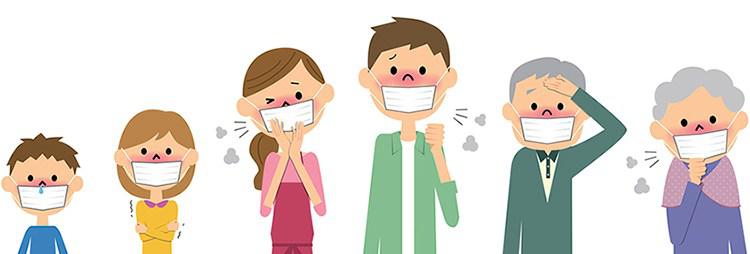Cold
A cold often starts with a runny nose and sore throat, followed by coughing and sneezing. You’re contagious a day or two before this starts and for as long as you feel sick, usually a week or two. It may be longer if you already have breathing problems or a weak immune system. You’re more likely to infect others during in the first few days, when symptoms are at their worst.
COVID-19
Caused by the virus SARS-CoV-2, this infection can cause fever, chills, trouble breathing, body aches, fatigue, cough, and nausea. But you can spread the virus 2 to 3 days before you notice any of these signs. You can also pass it on to others if you aren’t showing symptoms. If you are sick, you can be contagious for a while, so stay away from others until your symptoms improve and you’ve been without a fever for 3 days in a row. If you test positive for the virus but don’t have symptoms, it’s best to keep away from others for 10 days to see if you get sick.
Mononucleosis
This viral illness is also known as the kissing disease because that’s one of the ways you can pass it on to others. You might be contagious from the moment you’re infected, and that isn’t good because it often takes 4-7 weeks before you notice any of its flu-like symptoms. You can spread the disease the entire time you have it. Even once you feel better, you may be able to pass on the virus for as long as 18 months.
Norovirus
It can cause diarrhea, nausea, stomach pain, vomiting, headache, fever, and body aches. Just a few norovirus particles (your body sheds billions) can infect another person, most often by touching food or kitchen tools. You’re most contagious when you’re sick and for a few days after, but you can still spread it for 2 weeks or more after you feel better. Clean your hands regularly and wash food thoroughly to prevent spreading norovirus.
Conjunctivitis (Pinkeye)
Germs, irritants, or allergens can inflame the tissue, known as the conjunctiva, that lines your inner eyelid and the whites of your eyes. Your eye might be red, itchy, or watery. When it’s caused by bacteria, your eye may fill with pus. You can spread it to others for as long as you notice symptoms or for 24 hours after you start antibiotic drops. The milder viral form is contagious while you have symptoms and for a day or two before.
Hand, Foot, and Mouth Disease
This virus, common in young children, causes a red rash on the hands, feet, or bottom. It also may cause a fever, sore throat, and painful, blistering sores in the mouth. You’re most contagious the first week, but some people can still pass it on for weeks. You can get it from a simple cough, sneeze, or contact with spit or open blisters. It’s best to keep yourself or your child home if you have hand, foot, and mouth disease.
Whooping Cough
Most dangerous to babies, this bacterial infection has reappeared more recently in all ages because of missed vaccinations and booster shots. The “whoop” refers to the telltale sound your chest makes as you breathe in after a coughing fit, though this may not happen in teens or adults. You can pass it on, mostly through tiny droplets in the air, for 2 to 3 weeks after the cough starts. Antibiotics may be able to shorten this time.
Impetigo
Young kids most often get these contagious sores on the face, neck, hands, or butt. They may be unbroken, or wet and red, or crusty and yellow. The bacteria often get in when you cut, scrape, or irritate the skin. You can transfer it to other people who touch the sores. Proper handwashing could help prevent it. Doctors use antibiotics in a pill or ointment to kill the bacteria.
MRSA
Skin infection with MRSA, a type of staph bacteria called Staphylococcus aureus, could be serious because it doesn’t respond to several antibiotics. You may have sores, bumps, or a swollen cut with pus inside. You can give a MRSA infection to someone if they make contact with your infection or anything that touched it. If you have a MRSA infection, complete all treatments and follow your doctor’s instructions so it won’t spread to others.
E. coli
It’s one of the most common causes of bacterial diarrhea, but there are others like campylobacter, salmonella, and shigella. You can pass these bacteria on to others when you touch food or surfaces with unwashed hands, or by swimming in a pool when you’ve been sick. It’s contagious while you’re sick, and sometimes longer. Regular bathing and handwashing are the best ways to protect others and yourself.
Chest Cold
Sometimes called bronchitis, it happens when regular cold symptoms move down to inflame your lungs, which makes you cough. But whether it’s a cold, the flu, or some other virus, the rule of thumb is the same: You’re contagious for as long as you have symptoms, and maybe a little bit longer. To stop the spread, keep your hands clean at all times and cover your mouth when you sneeze or cough.
Chickenpox
This viral rash causes a fever or sore throat and telltale itchy spots all over your body. A new vaccine means most kids don’t get it anymore. But if yours do, it’s very contagious. Keep them home until all the sores crust over.
Shingles
Once you’ve had chickenpox, the virus lives on inside your body. It may come back later, often in middle age, as shingles, a painful, blistering rash. The chickenpox virus lives inside these blisters. Although the liquid that oozes out can’t give someone else shingles, it can give them chickenpox if they haven’t had it and haven’t been vaccinated.
Poison Ivy
Like its cousins, poison oak and poison sumac, its leaves have an oily sap (urushiol) that can make your skin red, swollen, and itchy. Until you wash it off with soap and water, you can pass the oil to someone who touches it, or to other parts of your body. Cool showers and calamine lotion can help relieve the itch. It should be gone in a week or two.
Source: www.webmd.com








